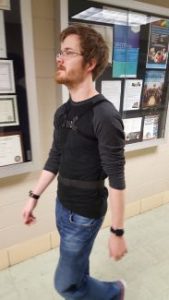 In the fall of 2015, Pain Consultants of East Tennessee was fortunate enough to coordinate research with Dr. Eric Wade, assistant professor of Mechanical Engineering at The University of Tennessee. He has been working on a new watch sized device that measures the total speed, changes in direction, change in velocity, power, and velocity of a part of the body in motion. It is small enough that it can be strapped to the wrists, ankles, feet, waist, or chest.
In the fall of 2015, Pain Consultants of East Tennessee was fortunate enough to coordinate research with Dr. Eric Wade, assistant professor of Mechanical Engineering at The University of Tennessee. He has been working on a new watch sized device that measures the total speed, changes in direction, change in velocity, power, and velocity of a part of the body in motion. It is small enough that it can be strapped to the wrists, ankles, feet, waist, or chest.
Phase One of the research study placed devices on these areas of 10 volunteer participants. They were then instructed through five movement activities which included: Five Time Sit to Stand, Timed Get Up and Go, One Minute Single Leg Balance, Five Times Box Lift, and Two Minute Walk Test. These five tests are well researched and recognized in the physical medicine community to evaluate a person’s coordination, strength, balance, and risk of falling. The tests can be used to assess people with varied medical history including Parkinson’s disease, Stroke, COPD, Cerebral Palsy, Osteo-Arthritis, Low Back Pain, Multiple Sclerosis, Peripheral Arterial Disease, Rheumatoid Arthritis, Total Knee Replacements, or Vestibular Disorders. Currently the tests are conducted with only written observation, hand held stop watches, and pre-determined heights or distances with each test set up. This is a fair way to get information to complement the patient’s concerns or current status. But when you can get hard computer information to substantiate the observed information, then you can make better conclusions and have better treatment for faster results and recovery. This allows for better protocol development, efficiency of treatment, and focus on rehabilitation. The current thinking in medicine is to practice through “evidence based medicine”. So the more measurements and numbers you have to validate your ideas, the better the new approaches can become.
Currently there is not much information on these testing activities for chronic pain specifically. So these watch sized sensors will assist in determining four things (1) comparative hard data points and results for chronic pain syndromes versus the above diagnoses for level of physical difficulty (due to muscle spasm, guarding) (2) the level of movement loss with chronic pain conditions (habitual soreness and limited posture motion) (3) the placement of the electronic sensors on the body for the best data point information for each of the five tests (4) accuracy of our observations versus the computer sensors read outs.
The information in being calculated currently and should be published in coming months. Phase Two should take place in Spring of 2016 and PCET is looking for another group of volunteer participants to assist us. The time required for participation is one visit to the PCET office for about 45 minutes which includes a short pain questionnaire, wearing light weight sensors on the chest, wrists, waist, and ankles, completing the five movement tests. For your time and effort there is a compensation gift card at the end of the visit.



